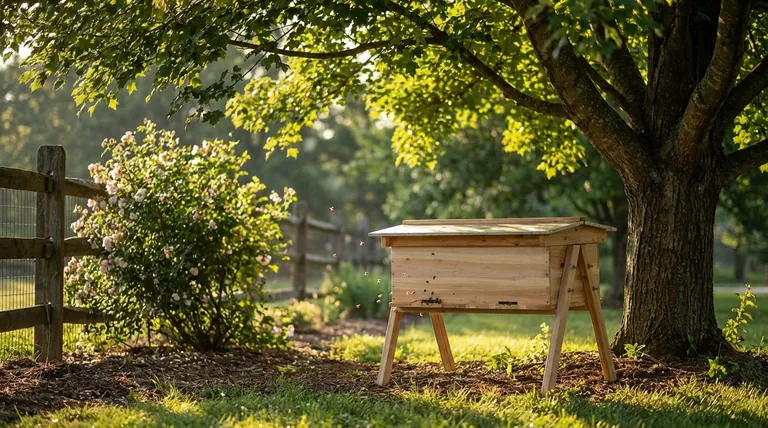The ideal location for a native bee hive is a sheltered position that receives gentle morning sun but is protected by deep shade for the remainder of the day. This is typically found under a tree, on a covered deck, or against the side of a house that does not face the harsh afternoon sun.
The core challenge of hive placement is temperature regulation. Your goal is to provide enough morning warmth to encourage foraging activity while completely avoiding the intense afternoon heat that can melt the hive structure and kill the colony.

The Core Principle: Managing Temperature
The single most important factor for the health of a native stingless bee colony is maintaining a stable internal temperature. Your placement of the hive directly controls their ability to do this.
Why Morning Sun is Essential
Native bees require warmth to become active. The gentle sun of the early morning acts as a natural "wake-up call," warming the hive and encouraging the bees to begin foraging for nectar and pollen.
A hive that gets no sun at all may be less active and less productive.
The Danger of Afternoon Heat
The resin, wax, and propolis that hold the hive together have a relatively low melting point. Direct, intense afternoon sun can easily heat a hive box beyond this limit.
This can cause the entire internal structure to collapse, destroying the brood, spilling the honey stores, and ultimately killing the colony. This is the primary risk you must avoid.
Protecting the Hive from Environmental Stress
Beyond temperature, a good location provides security and shelter from other environmental threats.
Shielding from Wind and Rain
Position the hive where it is protected from strong, prevailing winds and driving rain. Placing it under the eave of a house, on a covered veranda, or nestled among shrubs provides excellent protection.
Considering Predators and Pests
Ants are a common pest for native bee hives. Placing the hive on a stand or bench, rather than directly on the ground, makes it easier to defend against them.
Avoiding High-Traffic Areas
For the comfort of both your bees and your family, avoid placing the hive directly next to a busy doorway, path, or children's play area. Give them a clear and unobstructed flight path from the entrance.
Common Pitfalls to Avoid
Even with the best intentions, some common mistakes can compromise a colony's health.
The "All-Day Shade" Mistake
While afternoon shade is critical, putting the hive in a perpetually dark, damp location is not ideal. A lack of any morning sun can lead to a sluggish, less productive colony, especially in cooler months.
Forgetting Seasonal Changes
The angle of the sun changes dramatically between summer and winter. A spot that is perfectly shaded in winter might be fully exposed to the brutal summer afternoon sun. Always assess the location based on the summer sun's path.
The Winter Adjustment
In cooler climates during winter, you may need to shift the hive slightly to ensure it still catches some of that valuable, weaker morning sun. A small move of a meter or so can make a significant difference.
Making the Right Choice for Your Goal
Use this checklist to select the optimal location based on your priority.
- If your primary focus is colony survival: Prioritize deep and consistent afternoon shade above all else. This is the non-negotiable rule for preventing a catastrophic meltdown.
- If your primary focus is maximizing foraging: Ensure the hive gets at least 1-2 hours of direct, early morning sun (ending by 10 AM) to kickstart daily activity.
- If you live in a cooler region: You can be more flexible with morning sun exposure, but you must still verify the spot is fully shaded during the hottest part of a summer afternoon.
By thoughtfully managing their micro-environment, you provide your native bees with the stable and secure home they need to flourish.
Summary Table:
| Placement Goal | Key Priority | Ideal Location |
|---|---|---|
| Colony Survival | Avoid afternoon heat | Deep, consistent shade after 10 AM |
| Maximize Foraging | Encourage activity | 1-2 hours of gentle morning sun |
| Cooler Climates | Balance sun & shade | Morning sun, verified summer afternoon shade |
Ready to build a thriving apiary? Proper hive placement is just the start. For commercial beekeepers and distributors, having durable, high-quality equipment is essential for success. HONESTBEE supplies the beekeeping supplies and equipment you need to scale your operations efficiently and protect your investment. From hive boxes to protective gear, we support your business with reliable, wholesale-focused solutions.
Contact HONESTBEE today to discuss your equipment needs and get a quote.
Visual Guide

Related Products
- Long Langstroth Style Horizontal Top Bar Hive for Wholesale
- Multi-Function Hive Tool with Integrated Hammer for Beekeeping
- Professional Galvanized Hive Strap with Secure Locking Buckle for Beekeeping
- HONESTBEE Classic Pry Bar Hive Tool with High Visibility Finish for Beekeeping
- Professional Engraved Round Hive Number Tags for Beekeeping
People Also Ask
- What are the advantages of a top bar hive? Simpler, Bee-Centric Beekeeping for All
- What is a top bar bee hive? A Natural, Low-Stress Beekeeping Solution
- How are entrances designed in top bar hives? Master Beehive Layout for Maximum Honey
- What are the main differences between Langstroth hives and top bar hives? Choose the Right Hive for Your Beekeeping Goals
- What are the benefits of a top bar hive? A Natural, Low-Impact Approach to Beekeeping



















